You are currently browsing the monthly archive for January 2009.
Just hours before leaving for the airport we were given the privilege of visiting Tarango. Tarango is a non-governmental organisation which aims to create a just and poverty free society by organising and training disadvantaged women…

… to handcraft textiles and accessories for export using jute and hand looms:

Tarango also aims to promote leadership and entrepreneurship among women to create a more self reliant and gender balanced society, addressing the social issues surrounding women in the country:
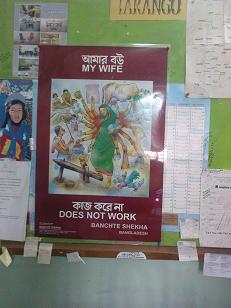
Tarangoexport their goods across the world (including to Europe, Australia, New Zealand, and Canada) and are very keen to learn about the western market so that they can increase their volumes, create more employment opportunities, and ultimately help more and more disadvantaged women. We left promising to send fashion magazines and details of fashion websites to help their designer understand these export markets further (even in the capital Dhaka it is very difficult to get hold of these types of magazines and they tend to be prohibitively expensive).
Open to on going innovation, products that they currently produce include tall football bags, greeting cards and ceramic Christmas decorations as well as jute shopping and beach bags and embroidery. One of my favourite products are these sturdy bags made with woven jute handles and…

… discarded cement sacks:

Out of all our visits, this was the one that most effected me. I loved the directness and selflessness of the CEO of Tarango whose focus was always on helping more and more disadvantaged women. I found this attitude 100% refreshing when compared to the focus of large retailers in the west where producing low cost disposable clothes appears to be the sole focus, with little thought to the process of production or to the welfare of the people manufacturing the garments.
Perhaps the highlight of our trip, on the last day we were taken to Bibi Russell’s studio in Dhaka where we were given the opportunity to meet Bibi and talk about her work.
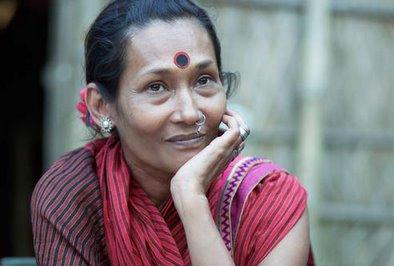
(Image from here)
Bibi was the first woman from Bangladesh to study at London College of Fashion. In 1975 after being spotted modelling her final collection at college, she was offered modelling contracts with designers including Yves Saint Laurent, Karl Lagerfeld and Giorgio Armani; and magazines including Vogue and Harper’s Bazaar. These experiences provided her with a rich experience and contacts that would then allow her to follow her real passion – promoting Bangladeshi textiles and handicrafts.
Bibi set up Bibi Productions in 1995 to promote Bangladeshi textiles and handicrafts within both the local and international market (mainly Europe and Scandinavia). The marketing message underlying this work is ‘Fashion for Development and Positive Bangladesh’. Her work has been internationally recognized and she has received many awards. These include the ‘Honorary Fellowship’ of the London Institute in 1999, title of ‘Designer for Development’ by the UNESCO in 1999, the title ‘Artist for Peace’ by the UNESCO in 2001 and the Peace Prize 2004 by the United Nations Associations of Spain. (http://www.bibirussell.org/).
Similar to Aarong, Bibi works to help people in Bangladesh by designing and researching beautiful textiles whose production can create jobs in rural areas. She currently provides employment for over 35,000 weavers in the country. Her textile scarves are rich and extremely luxurious to the touch designed around the weaving process and resulting qualities of the fabric:

However her work tends to differ from Aarong as she avoids the traditional imagery of kantha people and animals, and the use of applique and traditional embroidery. Instead she creates modern, high quality textiles in bright colours that show off the quality of the hand woven fabric itself, which can also hold their own in the western fashion world. Bibi is continually researching new ideas and approaches including using rickshaw painters to create brightly coloured bangles, accessories and furniture.


She has also produced gorgeous bangles made out of water hyacinth, a plant that grows widely in Bangladesh.

We were also given a sneak preview of a special collection she has been developing in aid of HIV sufferers (continuing her work in this area – http://www.ecofashionworld.com/Players/BIBI-RUSSEL-FOR-WE.html), including a sewn sari with fabulous ruffled edging:


As visitors we were very excited to see the combination of traditional design within the region being mixed with innovative detailing such as this tie design on the back of the sari bodice:

and the colourful shoes and accessories to complete the collection:

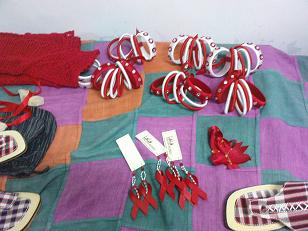
The Bibi Russell fashion show below also shows how Bibi has been able to successfully mix the influences of the east and the west without being predictable or excessively ethnic:
Further details of Bibi’s awe inspiring work can be found at:
- http://www.bibirussell.org
- http://www.thedailystar.net/magazine/2004/02/03/coverstory.htm
- http://rashedin.blogspot.com/2006/01/bibi-russell-pride-of-bangladesh.html
- Listen to interview at: http://uk.youtube.com/watch?v=0u4WSE3Gf2c
- Interview on the development of developing countries: http://uk.youtube.com/watch?v=g7ydoXVi8Ic&feature=related
- Photo gallery http://www.bangladeshshowbiz.com/bibi/bibi_photo_gallery.html
On Friday (the weekend in the Muslim world) we were given a bit of a break from our busy schedule to go shopping. The main retailer for foreigners to purchase local wares is Aarong.
“Established in 1978, Aarong is a fairtrade organisation dedicated to bring about positive changes to the live of disadvantaged artisans and underprivileged rural women by reviving and promoting their skills and craft. Reaching out to weavers, potters, brass workers, jewellers, jute workers, basket weavers, wood carvers, leather workers and more, Aarong embraces and nurtures a diverse representation of 65,000 artisans, 85% of whom are women.” http://www.brac-aarong.com/index2.php.
Interesting things to buy included purl earrings and necklaces (including pink and black purls):

Kantha embroidery including cushion covers:

With the exquisite tiny hand stitching which creates a soft rippled fabric:

As well as traditional kantha bedspreads including imagery of animals and people:

Wooden products including beautifully carved curry spoons and servers:

Later in the afternoon we were taken to the Bangladesh Jute Research Institute where scientists and academics have been carrying out research into jute processing and jute cloth. This involved starting with the raw jute which is made up of long, strong fibres which also offer some heat and fire resistance.
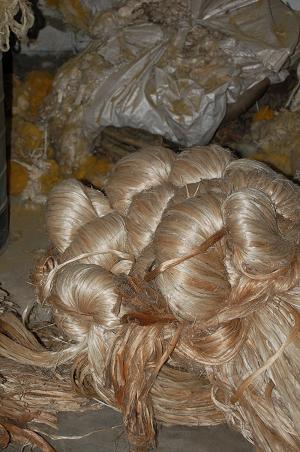
And then spinning, dying and weaving; often blending the jute with synethics (to create brightly coloured and durable blankets) or with cotton to create a softer cloth which could possibly be used for clothing:

They have also been printing jute cloth which could lend itself to widespread use in interiors:

And of course jute shopping bags:

Jute is a very interesting cloth, as it is quick and easy to grow, simple to dye and process, and also biodegrades. Bangladesh is the world’s largest producer of high quality jute providing an interesting opportunity for the country to grow economically.
In stark contrast to the dark and noise of the cotton weaving factory we were then given a guided tour of a cotton processing plant on the way back to Dhaka. The facilities were very high tech by comparison:
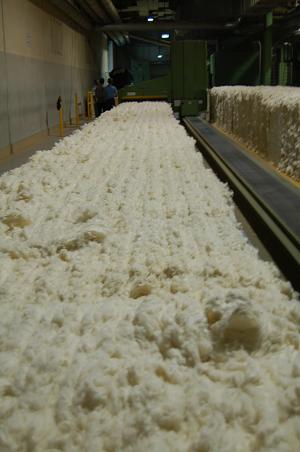

Allowing literally hundreds of spools to be managed and replaced at one go:

Resulting in spools of fine cotton either to be exported or dyed and woven in Bangladesh.

Then outside the factory we saw people filling and beating cotton mattresses in the sunshine:


